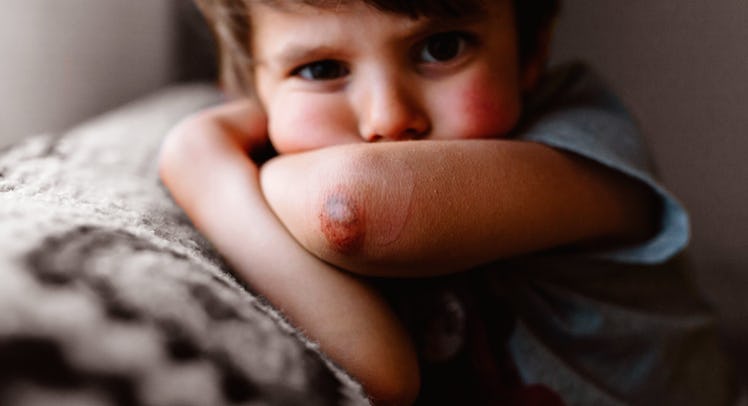How to Build a First Aid Kit for the Toddler Years
When you have a toddler prone to falling over there are some good things to have on hand for the inevitable injuries.

Toddlers are built like linebackers — kind of pudgy, close to the ground — so when they lose skirmishes with gravity and hit the ground they generally just pop up. But a kid that’s new to walking, and incredibly curious, will eventually get into trouble that requires more than a hug and a kiss on the booboo. That’s when parents need to reach for the first aid kit, a tool that solves for both peace of mind and, hopefully with far less frequency, bleeding. To do that, though, it has to contain the right supplies recommended by a pediatric emergency department physician.
“You’re trying to develop a go-to place for anything that might happen in the home,” explains Dr. Charles Jennissen from the Department of Emergency Medicine at the University of Iowa Carver College of Medicine. “Certainly the most likely thing is that kids are going to get cuts, lacerations, scrapes, and things like that. So you definitely want to have things that take care of that.”
That means the ever-present branded adhesive bandages, sure. But it also means having gauze pads in varying square sizes if the wound is too much for the plastic Sponge Bob bandage to handle. Gauze pads also require tape to keep them in place. And having tape will necessitate having first aid kit scissors to cut it with. That last bit is particularly important because rummaging for scissors as a kid bleeds and screams is no fun for anyone. The process of stocking a first aid kit can feel a bit like “If You Give a Mouse a Tourniquet.”
But before the cut is covered, some care is needed to clean the wound. Traditionally, parents have opted for hydrogen peroxide, alcohol, or iodine (a.k.a. “monkey blood”) for the truly old-school. Jennissen notes that not only can these products cause additional pain, they’re not really doing anything that can’t be accomplished by simply washing the wound.
“Really if you clean the wound well with soap and water, typically you don’t have to put on these astringents,” Jennissen says. “There are certain wounds that have ground in dirt. Soaking it in water in the tub and gently getting stuff out will help.”
But once the wound is clean, he suggests that parents have an antibiotic ointment in their kit to apply before the dressing. But Jennissen also reminds parents that for more significant wounds, they should be re-dressed daily. It’s no good to just slap on an adhesive bandage and let the kid wear it until it gets filthy and falls off. That’s because a dirty wound can quickly become an infected wound.
One of the symptoms of an infection is a fever. That’s why Jennissen also recommends that parents stock their first aid kit with an in-ear digital thermometer, which is fast and accurate for smaller kids who might not be feeling well. But there is a trick to them. The infra-red beam has got to hit the eardrum in order to be accurate, otherwise, the temperature will read low. So gently pull the ear up and outward before inserting the probe. But even then, to make sure the temperature that’s being taken is most accurate, Jennissen has an additional tip: “Do it two or three times and take the highest.”
He also notes that there are certain medications that can be particularly useful to include in a toddler first aid kit. Children’s liquid acetaminophen can be administered for pain, for instance. Also, a liquid antihistamine can be a good initial treatment when kids are experiencing certain allergic reactions. But in order to make sure the right doses are taken, parents should make sure the original dosage cups remain with the bottles or have a small syringe with millimeter measurements as a backup.
Parents should also have ice packs on hand for possible bumps and contusions. Chemical cold packs can stay in a first aid kit, but they are only good for one use. It helps to have a backup in the freezer. But when using any pack, there should be a cloth surrounding it so that the cold isn’t painful on the skin, but cooling deeper.
There are also some things a first aid kit does not need to have. Syrup of ipecac and activated charcoal might be used by emergency departments if a kid should ingest poison, but they can be difficult to administer at home and can even make things worse depending on what the child has ingested. The best first aid, then, is to call poison control at (800) 222-1222.
Also not needed are splinting materials. Jennissen notes that a broken limb is often best stabilized against a child’s body. Splinting, in fact, can cause a child more pain if the affected limb is jostled during the process.
But, in the end, a first aid kit won’t be able to solve every issue. If a parent isn’t feeling up to the challenge, take the kid to the professionals.